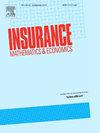Optimal life insurance and annuity decisions under money illusion
IF 2.2
2区 经济学
Q2 ECONOMICS
引用次数: 0
Abstract
This paper investigates the optimal consumption, investment, and life insurance/annuity decisions for a family in an inflationary economy under money illusion. The family can invest in a financial market that consists of nominal bonds, inflation-linked bonds, and a stock index. The breadwinner can also purchase life insurance or annuities that are available continuously. The family's objective is to maximize the expected utility of a mixture of nominal and real consumption, as they partially overlook inflation and tend to think in terms of nominal rather than real monetary values. We formulate this life-cycle problem as a random horizon utility maximization problem and derive the optimal strategy. We calibrate our model to the U.S. data and demonstrate that money illusion increases life insurance demand for young adults and reduces annuity demand for retirees. Our findings indicate that the money illusion contributes to the annuity puzzle and highlight the role of financial literacy in an inflationary environment.
金钱错觉下的最优寿险和年金决策
本文研究了通货膨胀经济中货币假象下家庭的最优消费、投资和人寿保险/年金决策。这个家庭可以投资于一个由名义债券、通胀挂钩债券和股票指数组成的金融市场。养家糊口的人还可以购买持续可用的人寿保险或年金。家庭的目标是最大化名义和实际消费混合的预期效用,因为他们部分忽略了通货膨胀,倾向于考虑名义而不是实际货币价值。我们将该生命周期问题形式化为随机视界效用最大化问题,并推导出最优策略。我们将我们的模型校准为美国的数据,并证明金钱错觉增加了年轻人的人寿保险需求,减少了退休人员的年金需求。我们的研究结果表明,货币错觉导致了年金之谜,并突出了金融知识在通货膨胀环境中的作用。
本文章由计算机程序翻译,如有差异,请以英文原文为准。
求助全文
约1分钟内获得全文
求助全文
来源期刊

Insurance Mathematics & Economics
管理科学-数学跨学科应用
CiteScore
3.40
自引率
15.80%
发文量
90
审稿时长
17.3 weeks
期刊介绍:
Insurance: Mathematics and Economics publishes leading research spanning all fields of actuarial science research. It appears six times per year and is the largest journal in actuarial science research around the world.
Insurance: Mathematics and Economics is an international academic journal that aims to strengthen the communication between individuals and groups who develop and apply research results in actuarial science. The journal feels a particular obligation to facilitate closer cooperation between those who conduct research in insurance mathematics and quantitative insurance economics, and practicing actuaries who are interested in the implementation of the results. To this purpose, Insurance: Mathematics and Economics publishes high-quality articles of broad international interest, concerned with either the theory of insurance mathematics and quantitative insurance economics or the inventive application of it, including empirical or experimental results. Articles that combine several of these aspects are particularly considered.
 求助内容:
求助内容: 应助结果提醒方式:
应助结果提醒方式:


